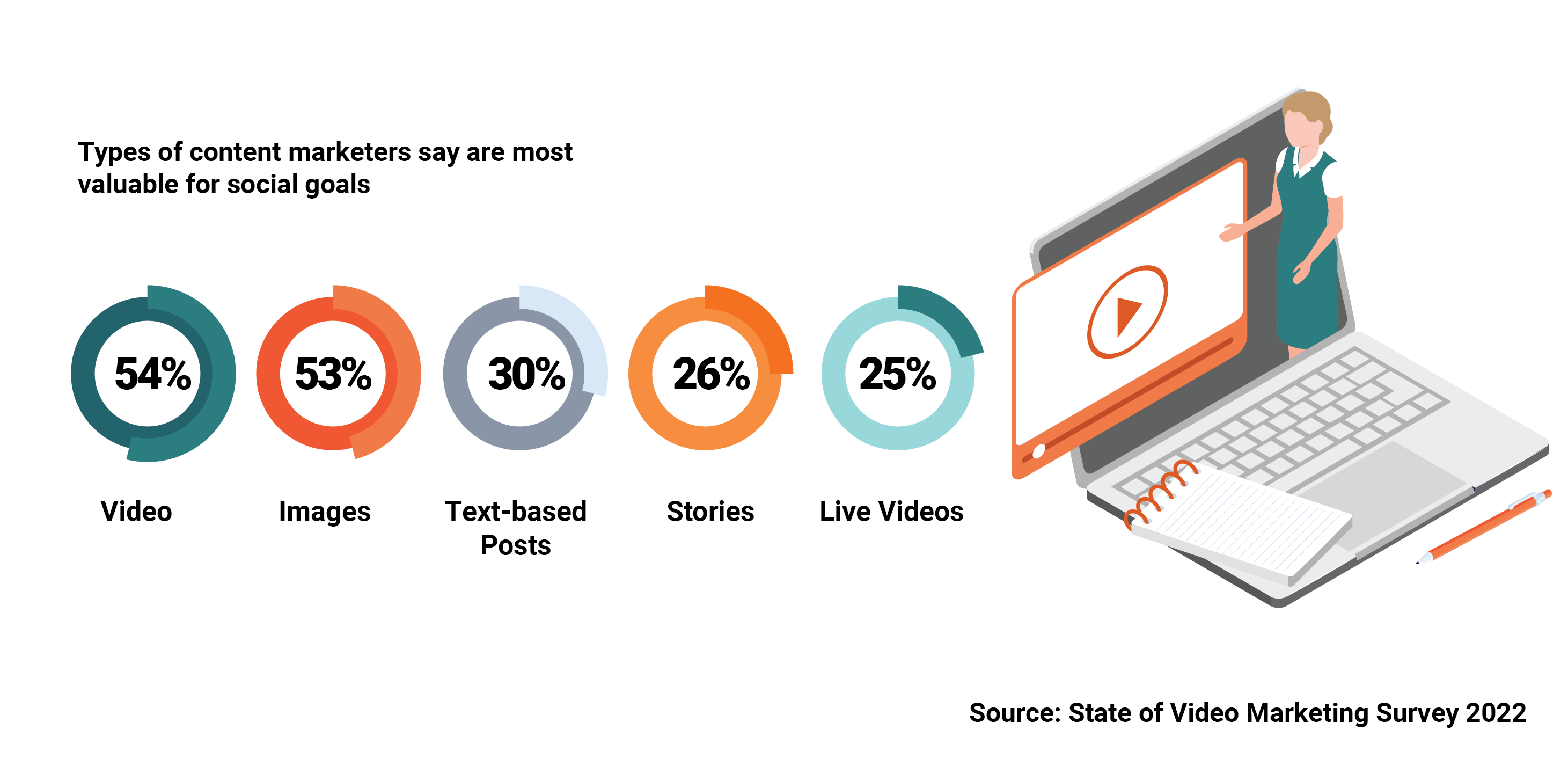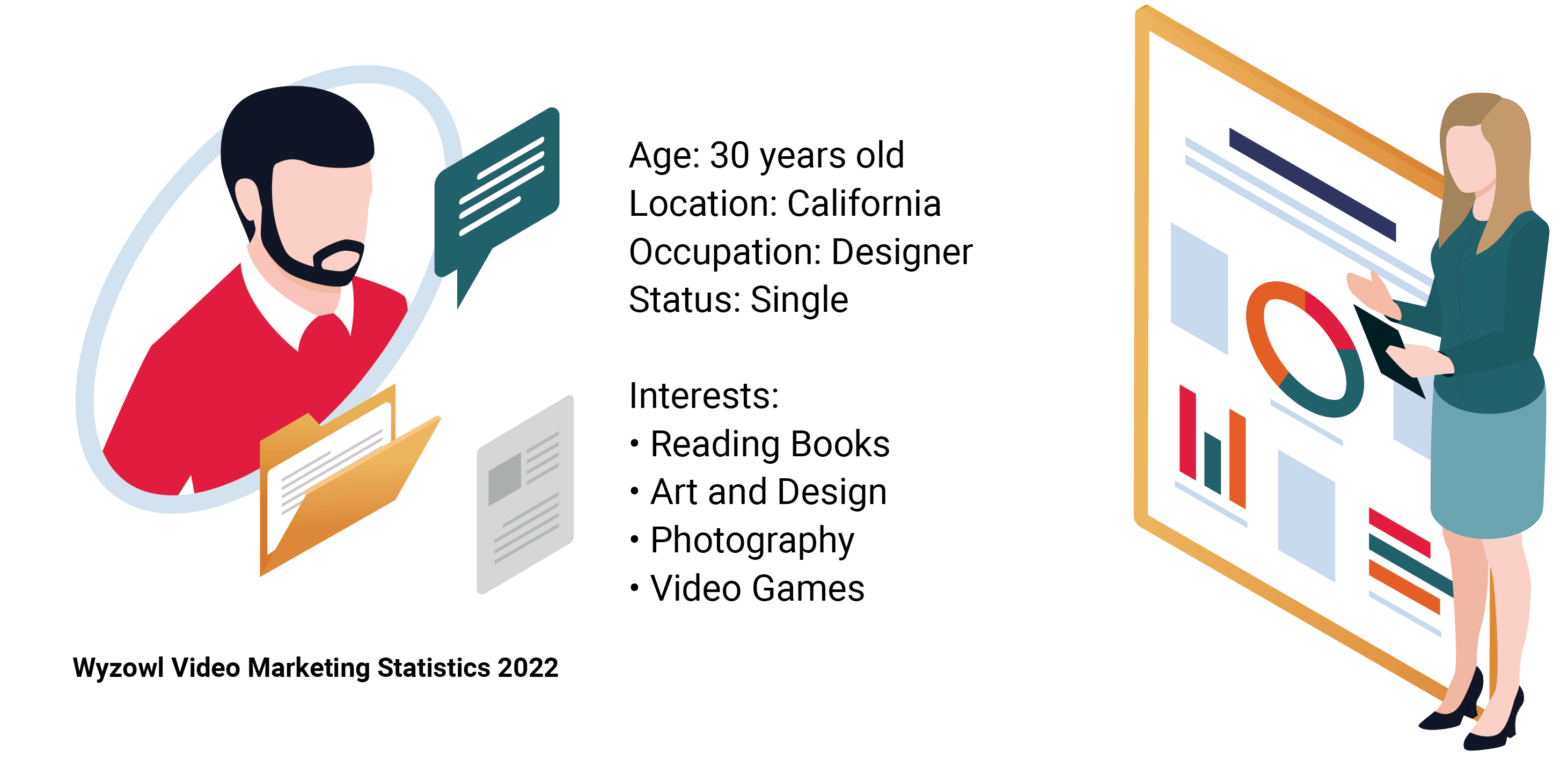If you’re thinking about using video marketing to strengthen your brand and set yourself apart from the herd, the time is now.
Video content has quickly become a hot commodity for marketers in recent years. And the popularity of video continues to skyrocket. So if video is not already a part of your digital marketing strategy, it may be time to reassess.
If you’re new to video marketing and don’t exactly know where to begin, you’ve come to the right place! In this guide, we cover video marketing fundamentals and the best strategies to get the show on the road.
Are you already familiar with video marketing but you need to brush up on a few skills? You’re welcome to use this guide too! Use the links below to jump to specific sections that matter the most to you.
Table of Contents
What Is Video Marketing
Video marketing is the use of video to increase brand awareness, generate excitement and engagement around products or services, educate customers, and drive sales.
It can sometimes overlap with content marketing, but video marketing can also be an entire business marketing strategy in and of itself.
Video marketing has been around for over a decade, entering the digital marketing landscape around 2005 when YouTube was launched. What has changed ten years later is how important video has become for every online platform and how easy it has become to consume.

Producing videos is also now more accessible and more cost-effective than ever before. Today, you can produce high-quality videos using just your smartphone and share them online – all in one day if you so desire!
Why Is Video Marketing Important
Sure, we’ve come a long way when it comes to creating and sharing videos online. But video marketing is more than just hitting the record button. Without the right strategy, your video may never reach the right audience.
That’s what this guide is for – we’ll show you exactly how to build an effective video marketing strategy and set you up for success. But first, let’s talk about why video marketing matters.
1. Video Consumption Is Soaring

People are watching more videos online than ever before. Wyzowl’s data shows that, on average, people are spending 19 hours a week watching videos online in 2022. To compare, people only spent an average of 10.5 hours a week consuming video in 2018 – that number has almost doubled in just four years!
Did being cooped up during the pandemic have anything do with the increase in video consumption? Perhaps.
But Wyzowl survey findings suggest that online audiences truly have a strong preference for video beyond entertainment purposes, with 88 percent wanting to see more video content from the brands they follow in the future.
2. Video Content Is King on Social Media

This may come as no surprise: the demand for video content on social media also plays a huge part in the rise of video marketing.
According to Sprout Social video marketing stats, over half of marketers agree that video is the most valuable content type for achieving social media marketing goals. And it’s not hard to see why.
People love watching videos on social media. In fact, when asked about their favourite type of content to engage with from brands on social media, consumers pointed to video. This was the result of a survey that Animoto conducted in 2018 but it still rings true today.
Why exactly is video so popular among social media users? We can give you three reasons:
- Video is dynamic and engaging
- Video is very easy to consume
- Video is shareable
 Of course, major social media platforms including YouTube and TikTok have always focused on video content. But Facebook, Instagram, Pinterest, and even LinkedIn are also now putting more emphasis on video to meet the demands of their users.
Of course, major social media platforms including YouTube and TikTok have always focused on video content. But Facebook, Instagram, Pinterest, and even LinkedIn are also now putting more emphasis on video to meet the demands of their users.
According to recent video marketing statistics, people watch one billion hours of videos on YouTube alone and generate billions of views every day. You read that right. Billions.
So if you’re not already one of the 62 percent of businesses using YouTube to post video content, you might be missing out on more than a handful of marketing opportunities. Needless to say, YouTube is the most popular platform among video marketers with 88 percent of them planning to include the platform in their video marketing strategy. Followed by LinkedIn, Instagram, and Facebook.
3. Video Increases Brand Awareness and Fosters Trust
Effective video content allows brands to build a deeper connection with their audience. The dynamic nature of video draws people in and provokes a more emotional response than with text or images alone.

That’s what makes video such a powerful marketing tool – 86 percent of marketers are choosing to include it in their digital marketing strategy with the majority saying video has helped them increase brand awareness.
These marketers have seen the potential of video content not only to gain brand exposure but also to build long-lasting customer trust. Why does this matter? Trust is the number one factor in nearly every purchasing decision for a customer.
Sure, video marketing can produce a solid ROI for your business, but it can do more than that. It can help you foster and maintain trust with new and existing audiences. When a customer trusts your brand, they’re more likely to commit to purchasing your products or subscribing to your services.
4. Video Boosts Conversions and Sales
Beyond building brand awareness and trust, video marketing can help businesses boost engagement and conversion rates, and ultimately increase sales.
 According to Wyzowl, 87 percent of marketers say video marketing has helped increase their web traffic. That’s because video content increases page quality and time spent on the page, making it an effective SEO tactic.
According to Wyzowl, 87 percent of marketers say video marketing has helped increase their web traffic. That’s because video content increases page quality and time spent on the page, making it an effective SEO tactic.
Video is also a powerful lead generation channel, with 86 percent of marketers reporting that video has helped them generate high-quality leads. This shows how video can positively impact a brand’s online presence through interactive, meaningful visuals. If audiences see great content, they’ll keep coming back for more. Need we say more?
Let’s not forget the impact of video on sales. 81 percent of marketers say that video has helped them directly increase sales. Think of video content as a sales pitch. It connects salespeople (aka brands) with prospects and educates them about products and services.
In essence, video marketing is an incredibly effective tool throughout the entire customer purchasing journey – from brand awareness to closing a sale and to delighting customers beyond the conversion stage.
How to Create an Epic Video Marketing Strategy
Before you hit the record button, you first need to have a solid video marketing strategy in place. Like any digital marketing strategy, the first step is to define the purpose of your video.
Don’t waste your time and money by creating video content blindly – having a clear purpose will save you and your team from re-shooting and re-editing. In short? If you fail to plan, you plan to fail.
To kickstart the process, ask yourself a few questions. Why are you building this campaign? What’s the purpose of your video? Who is your target audience? How will you measure success?
Now, let’s take it step-by-step…
Step 1: Define Your Audience

Who are you marketing to? Knowing your target audience is the key to a successful video campaign. This step helps you understand who you’re talking to, what kind of content they’re interested in watching, and where are they mostly spending their time.
The age-old approach is to create buyer personas of your ideal customers. Go through any marketing data you have on your customers and identify patterns. These include age, gender, location, interests, where are they consuming content online, and video content preferences.
Defining your target audience leads to a clearer understanding of who they are and what their needs are. This will make it easier for you and your team to produce video content that meets those needs.
Need a hand getting or understanding your audience insights? Check out our service page: Strategy to learn how our team of experts can help.
Step 2: Outline Your Scope and Budget
Arguably the least exciting part of digital marketing is setting a timeline and a budget for your campaign (unless that’s your jam), but it has to be done.
Regardless of how big or small the video project is, it can be expensive and time-consuming. So, save time and money with a proper project management plan. Have a solid timeline in place for every step of the process to avoid any mishap and headache from start to finish. Nothing and nobody is perfect – make sure that you plan for delays and unexpected changes to allow you to still deliver and meet deadlines.
As we’ve mentioned earlier, you don’t need fancy, expensive equipment to produce high-quality videos today. The advancements in smartphone technology have made it very easy to shoot and edit videos at home or in the office.
However, you need to think about what specific type or types of video you want to share online for your campaign (we will cover examples of marketing videos later in the article). This will dictate the resources you will require to make that happen and help you set a budget for your video or videos.
Step 3: Choose Where You Want to Distribute Your Video
Think about which online platform is best for your video campaign and which one will help you achieve your marketing goals.
Using audience insights and data analytics, identify what users on that platform are searching for and what they are most interested in watching. To dive even deeper, take a look at what your specific audience is watching on that platform. Are there trends you should be following?
When choosing a platform, you need to consider a few things including average watch time, video size and sound limitations, budget and paid promotion.
There are many places online to publish your videos. Below are a few examples and some best practices to follow for each one.
YouTube
There are so many platforms to publish videos online. The first one that probably comes to mind for most people is YouTube.
As discussed earlier, YouTube is the number one video hosting platform and garners billions of views every day. If you didn’t already know, it’s also the second most popular search engine next to Google.
If you want to expand your reach through video marketing, YouTube is no doubt a great place to start.
Best Practices:
- Create a channel layout that is easy to recognise and clearly communicates what your brand is all about
- Organise your content using playlists
- Publish video content regularly (even better if you post on the same days every week or month)
- Write attention-grabbing, click-worthy video titles
- Design custom YouTube thumbnails for your videos
- Include your brand logo on your videos
- Write detailed descriptions
- Add closed captions
- Optimise your video tags
A social media giant, Facebook saw the demand for video content in 2016 and has put emphasis on video ever since.
Facebook tends to favour brands that use video. This means that if you post a video, your page is more likely to show up on a customer’s newsfeed.
Studies also show that videos get more engagement on Facebook than text or images alone. According to Biteable research findings, a video ad received 480 percent more clicks than a still image!
Best Practices:
- Avoid slideshows of images, text montages, and looping videos
- Don’t be afraid to post longer videos if relevant (3 minutes or longer; ideal for episodic shows, live streaming, and more)
- Keep brand awareness videos fun, light-hearted, and ideally less than a minute long
- Consider using a 1:1 or 9:16 ratio for mobile users
- Post frequently and regularly
- Post authentic, meaningful content
There are so many opportunities to hook audiences on Instagram. Another social media giant, Instagram has a lot of in-platform features and tools that are practically designed for video marketing and social selling.
The biggest challenge that marketers face on Instagram is breaking through the noise. Because the platform is so saturated with video content, it can sometimes be hard to hook your target audience right off the bat.
However, if you provide your audience with something they can resonate with and truly value, you’ll start building a stronger online presence and get more engagement.
Instagram has four different video formats that you need to keep in mind:
- Reels: short videos (15 to 30 seconds)
- Stories: short 15-second videos that disappear after 24 hours
- Instagram Video: used to be called IGTV, these videos can be up to 60 minutes long
Best Practices:
- Share original video content
- Show your brand’s personality
- Post frequently and regularly
- Considering collaborating with influencers
A surprise to many, LinkedIn users absolutely love consuming video content. When posting videos on LinkedIn, however, you need to remember that users on this platform are professionals who are networking and job searching.
Best Practices:
- Share what you know through video that can help other people in your network
- Post industry and company news through video
- Publish broadcast and important discussions from industry events
Step 4: Select the Right Type of Marketing Video for Your Audience
When choosing the types of videos to create, the most important thing to remember is that they each need to fit a purpose.
Each video you make needs to fit the stage of the marketing funnel you’re targeting and point back to your marketing goals.
Another thing to keep in mind when selecting the type of video you’ll make is the message you want to get across to your audience. Not sure where to begin? Below are examples of marketing videos to kickstart the process.
Types of Marketing Videos
- Explainers
- Short videos explaining how your products or services work
- Explainer videos can also be used to highlight a concept or showcase how to do a specific task
- Brand Videos
- Showcase company vision and mission
- Typically created as a part of a larger ad campaign
- Creative way to build awareness around your company or brand
- One of the main goals of brand videos is to create intrigue
- Product Demos
- Show how your physical product works
- Tour of a software
- Video Ads and Promos
- For the awareness stage of the marketing funnel, video ads should focus on sharing your brand’s values and story
- For the decision stage, video ads should have very clear and strong calls to action to drive conversions
- Promote sales and discounts
- Product Reviews and Testimonials
- Digital word-of-mouth
- Great way to build customer trust
- Highlight customer sentiments, business awards and successes to prove credibility
- Educational Videos
- Instructional or how-to videos
- The main goal is to teach your customers how to use your product or service to help solve a problem they may have
- Infographics
- Great for social media as infographic videos are extremely shareable
- Fun and entertaining way to prove that you know your stuff
- Event Videos
- Highlights from conferences or industry events
- Round table discussions about relevant topics
Step 5: Identify How You Will Measure Success
One of the most satisfying aspects of digital marketing is that you can measure success. It’s no different for video marketing.
Once you’ve defined your video marketing goals, you need to identify which metrics to track to help you do three things:
- Let you know what’s working and what isn’t
- Let you find ways to improve your video to help you accomplish your goals
- Helps you discover new video content opportunities
It’s important that you track the performance of your video marketing efforts so you can pivot and make adjustments when you need to. This allows you to reach your goals much more efficiently.
Below are some popular video marketing metrics to get you started.
- View Count
- Play Rate
- Social Engagement
- Click-Through Rate (CTR)
- Bounce Rate
- Conversion Rate
Roll Camera
Phew! That was a doozy – congrats if you’ve made it this far! Needless to say, there is a lot to video marketing.
Creating high-quality, visually appealing video content is one thing. But creating video that resonates with audiences, creates an emotional impact, and drives sales is another thing.
Video marketing is more than just hitting the record button, posting it online, and crossing your fingers hoping it will reach the right audience. It takes practice, patience, and a lot of experimenting.
It can be overwhelming at first but video marketing is so rewarding once you get it right. And as the popularity of video continues to skyrocket, making it a big part of your digital marketing strategy is a no-brainer.
Need additional resources for video marketing? Let us do the heavy lifting for you. At DGA, we have expert digital marketing strategists and video marketing gurus to help you reach your goals. To learn more about how we can help, check out our digital service page: Video. Prefer to chat over the phone? Feel free to give us a call!






